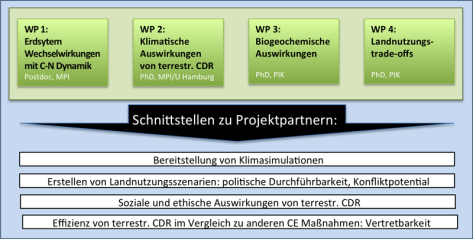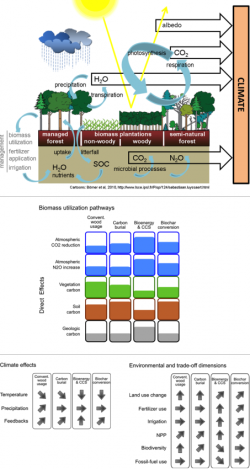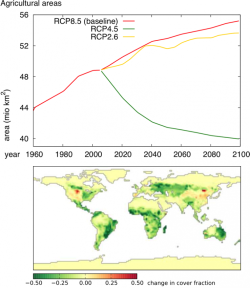
CE-Land
Climate Engineering on Land: Potentials and Side-Effects of Afforestation and Biomass Plantations as Instruments for Carbon Extraction
- PD Dr. Dieter Gerten // Potsdam Institute for Climate Impact Research (PIK) // PI
gerten@pik-potsdam.de - Dr. Daniela Kracher // Max Planck Institute for Meteorology, Hamburg (MPI-M) // PI
daniela.kracher@zmaw.de - Prof. Dr. Wolfgang Lucht // PIK // PI
wolfgang.lucht@pik-potsdam.de - Dr. Julia Pongratz // MPI-M // PI
julia.pongratz@mpimet.mpg.de - Prof. Dr. Martin Claussen // MPI-M
- Dr. Tim Beringer // PIK
- Dr. Christian Reick // MPI-M
- Lena Boysen // PIK
- Vera Heck // PIK
- Dorothea Mayer // MPI-M
Project Description
Terrestrial carbon dioxide removal (CDR) through directed land use change is one option for Climate Engineering (CE). However, consistent estimates of carbon sequestration potentials of alternative terrestrial CDR pathways and their climatic, environmental, and socioeconomic consequences are missing. The project CE-LAND will investigate comprehensively four types of terrestrial CDR: semi-natural forest, managed forest, woody biomass plantations, and herbaceous biomass plantations. Emerging trade-offs due to increasing competition for natural resources and resulting consequences for political and ethical evaluation of CE will be assessed in close collaboration with partner projects.

|
|
||
K E Y Q U E S T I O N S
|
||
|
||
|
||
|
||
Approach
Biosphere and climate simulations will be performed with the Earth system model of the MPI for Meteorology, MPI-ESM, and LPJmL of the PIK Potsdam.

Fig. 2: Interactions between terrestrial CDR, carbon, and climate.
The upper panel shows the interactions of the four types of terrestrial CDR – natural forest, managed forest, woody biomass plantations, herbaceous biomass plantations – with climate through biophysical and biogeochemical effects that will be investigated in the proposed project. The lower panel shows the implications of biomass utilization pathways for carbon pools, greenhouse gas mitigation potentials, the environment, climate, and socioeconomic consequences, which depict the multiple dimensions of this project. The volumes of pools and directions of effects are tentative and will be assessed in this project.
Scenarios
Afforstation scenarios are based on the “representative concentration pathways” (RCP) of the IPCC CMIP5 experiments. These scenarios will be improved in an iterative exchange with partner projects to account for political feasibility, risks of conflicts, and social acceptability.

Fig. 3: Potential scenarios of terrestrial CDR.
The land use distribution of the representative concentration pathway (RCP) 8.5 will be replaced by that of the RCP4.5 (afforestation) and RCP2.6 (expansion of agricultural land for bioenergy production). In individual model simulations, all available area in RCP 4.5 and 2.6 as compared to 8.5 will be cultivated with one of the four types of terrestrial CDR.
